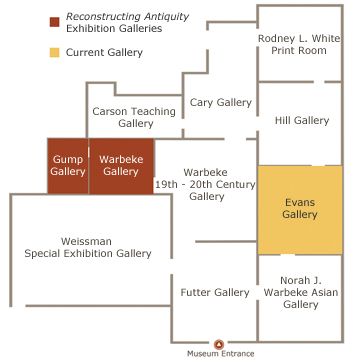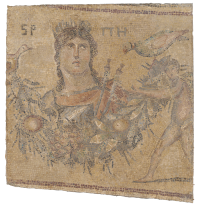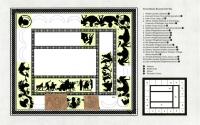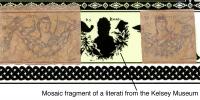Bust of Euterpe, muse of music, holding a double flute
Learn more about the object below
This fragments of a mosaic floor once decorated the dining room (triclinium) of a Roman house in Gerasa (present-day Jerash, Jordan). Twenty-two other fragments of the floor are now in the Pergamonmuseum in Berlin, with additional pieces in other museums and private collections. All known fragments of the pavement were unearthed between 1907 and 1935 and have been published. The illustration at right is one possible reconstruction of how these fragments originally may have been positioned on a large floor mosaic.
This mosaic fragment represents a muse, popular subjects with Roman artists and their clients, as were the renowned authors and intellectuals of earlier Greek antiquity. The Gerasa mosaic, like several other mosaics from around the Roman world, pairs the muses with famous historical literati. In addition to the representations of Erato and Euterpe included in this exhibition, the mosaic features Ourania (muse of astronomy), Kalliope (muse of epic poetry), Klio (muse of history), Terpsichore (muse of choral dancing), Olympos (musician), Homer (epic poet), Anakreon, Alkman, and Stesichoros (lyric poets), and Thucydides (historian).
As the god of wine, Dionysos was an especially suitable subject for the decoration of dining rooms and other spaces in which drinking was an essential component of the activities that took place. The central portion of the Gerasa mosaic includes Dionysiac scenes such as the triumph of Dionysos returning from the East and the lewd behavior of the Greek hero Herakles after a drinking contest with the god of wine. In this fragment, also now in the collection of the Yale University Art Museum, Dionysos and Ariadne are pulled by centaurs (mythical human/equine animals), surrounded by a procession of maenads, satyrs, and a boy riding a panther.
The corners of the Gerasa mosaic contain the four seasons. These figures are not only identified by inscription but, as on numerous Roman sarcophagi, also possess attributes appropriate for their particular time of year. Generally symbolic of natural order and prosperity, the seasons also boasted a special relationship with Dionysos because of their role in the cultivation of grapes and wine production.
Label texts by Lisa Brody, Associate Curator of Ancient Art, Yale University Art Gallery
Suggested readings:
C.H. Kraeling, Gerasa: City of the Decapolis (New Haven 1938) 351-52, 458-59
H. Joyce, "A Mosaic from Gerasa in Orange, Texas and Berlin," RM 87 (1980), 307-325.
H. Joyce, Dionysiac Artists and Cult Practices in a Mosaic from Gerasa[abstract]," AJA 84.2 (1980), 215-6.
M. Piccirillo, The Mosaics of Jordan (1993), 282-3.
D. von Boeselager, "Zum Mosaik aus Gerasa," in R. Ling, ed., Fifth International Colloqium on Ancient Mosaics, Journal of Roman Archaeology Supplementary Series 9 (1995), 57-63.
R. Talgam and Z. Weiss, The Mosaics of Dionysos at Sepphoris, Qedem 44 (2004), 5-7.
C. Kondoleon, Domestic and Divine: Roman Mosaics in the House of Dionysos(1995), 215-217.





